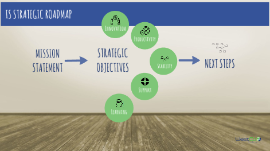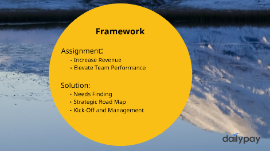The Strategic Roadmap
Transcript: Zoom out for more assets Asset library Team Alignment Ensuring all team members are on the same page is crucial for effective strategy execution. Collaboration and communication are key to aligning goals, tasks, and expectations across departments. Collaboration and Communication Effective collaboration and communication are essential for success in strategy implementation. Stakeholder Engagement Engaging stakeholders at every stage of the strategic roadmap ensures their buy-in and support. Regular communication and involvement foster a sense of ownership and commitment to the overall success of the strategy. Market Analysis and Research Success Measurement Implementation Planning Celebrating achievements is crucial for success measurement. Acknowledging milestones boosts team morale and fosters a culture of improvement. SWOT Analysis Process The SWOT analysis process involves identifying internal strengths and weaknesses, as well as external opportunities and threats. This structured approach helps organizations assess their current position and develop informed strategies. Celebrating Achievements Establishing Key Performance Indicators Implementing a strategic roadmap requires meticulous planning and efficient allocation of resources. Success hinges on setting clear milestones and closely monitoring progress. Recognizing and celebrating milestones is vital for team motivation and morale. It validates progress and reinforces commitment to the strategic objectives. Threats: External Challenges to Mitigate Key Performance Indicators (KPIs) are essential metrics used to evaluate the success of strategic initiatives. By establishing KPIs, organizations can track progress, measure performance, and make data-driven decisions to drive the roadmap towards success. Threats are external risks that pose challenges to strategic objectives. Recognizing and addressing threats proactively is essential for ensuring long-term success and sustainability. Developing Strategies Understanding the target audience is crucial for strategic decisions and effective communication strategies. Creating Action Plans Tracking Progress Opportunities: External Factors for Growth Exploring the Essentials of SWOT Analysis Flexibility in Strategy Execution Revising the Roadmap Measuring and monitoring progress towards milestones is key for success measurement. Utilizing performance metrics allows for effective evaluation and course correction if needed. Opportunities identified in a SWOT analysis are external factors that can drive growth. These may include market trends, new partnerships, or technological advancements to leverage for strategic advantage. Action plans within the roadmap outline the specific tasks, timelines, and responsibilities necessary for achieving outlined objectives. They provide a structured approach to task execution and ensure alignment towards common goals. Defining Objectives Regularly revisiting and revising the strategic roadmap allows for agility, proactiveness, and alignment with the company's objectives. Adapting to changes swiftly is vital for responding to market shifts, competitor actions, and internal challenges. Setting Clear Goals Clearly defining objectives allows teams to align their efforts towards a common goal. Objectives should be specific, measurable, achievable, relevant, and time-bound (SMART), ensuring clarity and accountability in goal-setting. Strengths: Internal Factors that Drive Success In SWOT analysis, strengths are internal factors that give an organization a competitive advantage. This may include skilled employees, unique resources, or innovative products/services. Adapting to Changes Allocating Resources Effectively Establishing clear goals is crucial in driving strategic initiatives. It provides a focused direction for the organization and acts as a benchmark for success. Without defined objectives, progress can become aimless and ineffective. Weaknesses: Areas Needing Improvement Competitive Analysis Understanding Target Audience Resource allocation involves distributing manpower, finances, and time according to project needs and priorities. It requires careful balance and optimization to maximize efficiency and achieve desired outcomes. Weaknesses refer to internal factors that hinder an organization's growth. Addressing weaknesses is crucial for developing a robust strategy roadmap and maintaining market competitiveness. Embracing adaptability is crucial in the ever-evolving business landscape. Flexibility in strategy execution ensures relevance and alignment with goals. Assessing competitors' strengths, weaknesses, and market positioning to identify opportunities for differentiation. Analyzing demographics, psychographics, and behavior patterns to tailor marketing strategies. Performance Review Meetings Conduct regular performance review meetings to discuss progress, challenges, and opportunities with key stakeholders. Collaboration and open communication are essential for

















